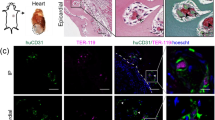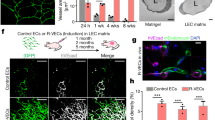Abstract
Previously we showed the superior in vitro survival of human telomerase reverse transcriptase (hTERT)-transduced human endothelial cells (EC). Here we show that retroviral-mediated transduction of hTERT in human dermal microvascular EC (HDMEC) results in cell lines that form microvascular structures when subcutaneously implanted in severe combined immunodeficiency (SCID) mice. Anti-human type IV collagen basement membrane immunoreactivity and visualization of enhanced green fluorescent protein (eGFP)-labeled microvessels confirmed the human origin of these capillaries. No human vasculature was observed after implantation of HT1080 fibrosarcoma cells, 293 human embryonic kidney cells, or human skin fibroblasts. Intravascular red fluorescent microspheres injected into host circulation were found within green “telomerized” microvessels, indicating functional murine–human vessel anastamoses. Whereas primary HDMEC-derived vessel density decreased with time, telomerized HDMEC maintained durable vessels six weeks after xenografting. Modulation of implant vessel density by exposure to different angiogenic and angiostatic factors demonstrated the utility of this system for the study of human microvascular remodeling in vivo.
This is a preview of subscription content, access via your institution
Access options
Subscribe to this journal
Receive 12 print issues and online access
$209.00 per year
only $17.42 per issue
Buy this article
- Purchase on Springer Link
- Instant access to full article PDF
Prices may be subject to local taxes which are calculated during checkout






Similar content being viewed by others
References
L'Heureux, N., Paquet, S., Labbe, R., Germain, L. & Auger, F.A. A completely biological tissue-engineered human blood vessel. FASEB J. 12, 47–56 (1998).
Nör, J., Joan, C., Mooney, D. & Polverini, P. Vascular endothelial growth factor (VEGF)-mediated angiogenesis is associated with enhanced endothelial cell survival and induction of Bcl-2 expression. Am. J. Pathol. 154, 375–384 (1999).
Schechner, J. et al. In vivo formation of complex microvessels lined by human endothelial cells in an immunodeficient mouse. Proc. Natl. Acad. Sci USA 97, 9191–9196 (2000).
Jain, R.K., Schlenger, K., Höckel, M. & Yuan, F. Quantitative angiogenesis assays: progress and problems. Nat. Med. 3, 1203–1208 (1997).
Palmer, R., Ferrige, A. & Moncada, S. Nitric oxide release accounts for the biological activity of EDRF. Nature 327, 524–526 (1987).
Pili, R. et al. Altered angiogenesis underlying age-dependent changes in tumor growth. J. Natl. Cancer Inst. 86, 1303–1314 (1994).
Reed, M.J., Corsa, A.C., Kudravi, S.A., McCormick, R.S. & Arthur, W.T. A deficit in collagenase activity contributes to impaired migration of aged microvascular endothelial cells. J. Cell. Biochem. 77, 116–126 (2000).
Rivard, A. et al. Age-dependent impairment of angiogenesis. Circulation 99, 111–120 (1999).
Swift, M.E., Kleinman, H.K. & DiPietro, L.A. Impaired wound repair and delayed angiogenesis in aged mice. Lab. Invest. 79, 1479–1487 (1999).
Whikehart, D.R., Register, S.J., Chang, Q. & Montgomery, B. Relationship of telomeres and p53 in aging bovine corneal endothelial cell cultures. Invest. Ophthalmol. Vis. Sci. 41, 1070–1075 (2000).
Chang, E. & Harley, C. B. Telomere length and replicative aging in human vascular tissues. Proc. Natl. Acad. Sci USA 92, 11190–11194 (1995).
Maier, J.A., Voulalas, P., Roeder, D. & Maciag, T. Extension of the life-span of human endothelial cells by an interleukin-1 alpha antisense oligomer. Science 249, 1570–1574 (1990).
Watanabe, Y., Lee, S.W., Detmar, M., Ajioka, I. & Dvorak, H.F. Vascular permeability factor/vascular endothelial growth factor (VPF/VEGF) delays and induces escape from senescence in human dermal microvascular endothelial cells. Oncogene 14, 2025–2032 (1997).
Shelton, D.N., Chang, E., Whittier, P.S., Choi, D. & Funk, W.D. Microarray analysis of replicative senescence. Curr. Biol. 9, 939–945 (1999).
Ades, E.W. et al. HMEC-1 Establishment of an immortalized human microvascular endothelial cell line. J. Invest. Dermatol. 99, 683–690 (1992).
Dubois, N.A., Kolpack, L.C., Wang, R., Azizkhan, R.G. & Bautch, V.L. Isolation and characterization of an established endothelial cell line from transgenic mouse hemangiomas. Exp. Cell Res. 196, 302–313 (1991).
Candal, F. J. et al. BMEC-1: a human bone marrow microvascular endothelial cell line with primary cell characteristics. Microvasc. Res. 52, 221–234 (1996).
Fontijn, R. et al. Maintenance of vascular endothelial cell-specific properties after immortalization with an amphotrophic replication-deficient retrovirus containing human papilloma virus 16 E6/E7 DNA. Exp. Cell Res. 216, 199–207 (1995).
Cockerill, G.W., Meyer, G., Noack, L., Vadas, M.A. & Gamble, J.R. Characterization of a spontaneously transformed human endothelial cell line. Lab. Invest. 71, 497–509 (1994).
Rhim, J.S. et al. A human vascular endothelial cell model to study angiogenesis and tumorigenesis. Carcinogenesis 19, 673–681 (1998).
Yang, J. et al. Human endothelial cell life extension by telomerase expression. J. Biol. Chem. 274, 26141–26148 (1999).
Maniotis, A.J. et al. Vascular channel formation by human melanoma cells in vivo and in vitro: vasculogenic mimicry. Am. J. Pathol. 155, 739–752 (1999).
Folberg, R., Hendrix, M.J. & Maniotis, A.J. Vasculogenic mimicry and tumor angiogenesis. Am. J. Pathol. 156, 361–381(2000).
Capogrossi, M. & Passaniti, A. An in vivo angiogenesis assay to study positive and negative regulators of neovascularization. In Vascular disease: molecular biology and gene therapy protocols. Methods Mol. Med. (ed. Baker, A.H.) 367–384 (Humana Press, Totowa, NJ; 1999).
Shay, J.W. & Wright, W.E. The use of telomerized cells for tissue engineering. Nat. Biotechnol. 18, 22–23 (2000).
Thomas, M., Yang, L. & Hornsby, P.J. Formation of functional tissue from transplanted adrenocortical cells expressing telomerase reverse transcriptase. Nat. Biotechnol. 18, 39–42 (2000).
Jiang, X. et al. Telomerase expression in human somatic cells does not induce changes associated with a transformed phenotype. Nat. Genet. 21, 111–114 (1999).
Morales, C. et al. Absence of cancer-associated changes in human fibroblasts immortalized with telomerase. Nat. Genet. 21, 115–118 (1999).
Carmeliet, P. Mechanisms of angiogenesis and arteriogenesis. Nat. Med. 6, 389–395 (2000).
Helmlinger, G., Endo, M., Ferrara, N., Hlatky, L. & Jain, R.K. Growth factors: formation of endothelial cell networks. Nature 405, 139–141 (2000).
Risau, W. Mechanisms of angiogenesis. Nature 386, 671–674 (1997).
Asahara T. et al. Isolation of putative progenitor endothelial cells for angiogenesis. Science 275, 964–967 (1997).
Shi, Q. et al. Evidence for circulating bone marrow-derived endothelial cells. Blood 92, 362–367 (1998).
Takahashi, T. et al. Ischemia- and cytokine-induced mobilization of bone marrow-derived endothelial progenitor cells for neovascularization. Nat. Med. 5, 434–438 (1999).
Kalka, C. et al. Transplantation of ex vivo expanded endothelial progenitor cells for therapeutic neovascularization. Proc. Natl. Acad. Sci USA 97, 3422–3427 (2000).
Christofidou-Solomidou, M., Bridges, M., Murphy, G.F., Albelda, S.M. & DeLisser, H.M. Expression and function of endothelial cell alpha v integrin receptors in wound-induced human angiogenesis in human skin/SCID mice chimeras. Am. J. Pathol. 151, 975–983 (1997).
Yuan, F. et al. Time-dependent vascular regression and permeability changes in established human tumor xenografts induced by an anti-vascular endothelial growth factor/vascular permeability factor antibody. Proc. Natl. Acad. Sci USA 93, 14765–14770 (1996).
Normand, J. & Karasek, M.A. A method for the isolation and serial propagation of keratinocytes, endothelial cells, and fibroblasts from a single punch biopsy of human skin. In Vitro Cell. Dev. Biol. Anim. 31, 447–455 (1995).
Romero, L.I., Zhang, D.N., Herron, G.S. & Karasek, M.A. Interleukin-1 induces major phenotypic changes in human skin microvascular endothelial cells. J. Cell. Physiol. 173, 84–92 (1997).
Kinsella, T.M. & Nolan, G.P. Episomal vectors rapidly and stably produce high-titer recombinant retrovirus. Hum. Gene Ther. 7, 1405–1413 (1996).
Passaniti, A. et al. A simple, quantitative method for assessing angiogenesis and antiangiogenic agents using reconstituted basement membrane, heparin, and fibroblast growth factor. Lab. Invest. 67, 519–528 (1992).
Acknowledgements
Garry Nolan (Stanford University, Stanford, CA) provided the LZRS retroviral vector and the Phoenix packaging cell line. The LZRS-eGFP construct was provided by Helen Deng (Stanford University, Stanford, CA). Endostatin-specific IgG was a gift from Rupert Timpl (Max Planck Institute, Martinsreid, Germany). We thank Michel Prunieras for his advice and many helpful discussions. This work was supported by NIH PO-1 AR44012, the Carl J. Herzog Foundation, and the Dermatology Foundation. J. Yang received a research fellowship from Warner Lambert Consumer Healthcare through the Dermatology Foundation. The work by W.C.M. was performed under the auspices of the U. S. Department of Energy by Lawrence Livermore National Laboratory under Contract No. W-7405-Eng-48. W.C.M. was also supported in part by NIH AI22511. G.S.H. is a Terman Fellow.
Author information
Authors and Affiliations
Corresponding author
Rights and permissions
About this article
Cite this article
Yang, J., Nagavarapu, U., Relloma, K. et al. Telomerized human microvasculature is functional in vivo. Nat Biotechnol 19, 219–224 (2001). https://doi.org/10.1038/85655
Received:
Accepted:
Issue Date:
DOI: https://doi.org/10.1038/85655
This article is cited by
-
A prospect of cell immortalization combined with matrix microenvironmental optimization strategy for tissue engineering and regeneration
Cell & Bioscience (2019)
-
Expansion of functional personalized cells with specific transgene combinations
Nature Communications (2018)
-
Proliferation status defines functional properties of endothelial cells
Cellular and Molecular Life Sciences (2017)
-
Poly(Ethylene Glycol) Hydrogel Scaffolds Containing Cell-Adhesive and Protease-Sensitive Peptides Support Microvessel Formation by Endothelial Progenitor Cells
Cellular and Molecular Bioengineering (2016)
-
Funktionale Zelllinien durch neue Immortalisierungsprotokolle
BIOspektrum (2012)



